Keep It Simple, Make It Bold: How Bolt Rewrote the Rules of Employer Branding
What do grandmas, dogs, and screaming seagulls have in common? They’ve all played a part in Bolt’s globally recognized employer branding, led with honesty, humor, and bold simplicity. In this exclusive interview with Kadi Poll, Global Employer Branding Manager at Bolt, we talked about scrappy strategies, storytelling that resonates, and why keeping things human might just be the most strategic move in 2025.
Bucharest, May 2025 This interview was conducted during EB. Con in Bucharest, a flagship employer branding event organized by Catalyst Solutions, Romania’s market-leading employer branding agency and a proud member of the European Association of Employer Branding Agencies (EAEBA). The conversation took place between Kadi Poll, Global Employer Branding Manager at Bolt, and Ádám Horváth, Board Member of EAEBA and co-founder of Brandfizz Employer Branding, Hungary. Let’s take a unique look into how one of Europe’s fastest-growing tech companies is redefining employer branding, with simplicity, boldness, and a deeply human touch!

Adam Horvath (EAEBA): Bolt’s employer brand feels refreshingly authentic. Vibrant, sharp, and deeply resonant with Gen Z talent. While many legacy companies struggle to stay relevant, Bolt seems to strike the right chord naturally. In your view, how much of this authenticity stems from the brand’s DNA, how much from the company culture, and how much from your personal philosophy as an employer branding leader?
Kadi Poll (Bolt): It’s really a mix of all three.
Bolt as a brand has always been bold and straightforward. The culture matches that fast-moving, ownership-driven, and all about the freedom to execute.
And personally, I’m a simple girl from a tiny village in Estonia. I want to talk to people like people. Honest, human. I want to create things that feel real, with a bit of risk, a bit of rawness. I think when we’re upfront from the beginning, we save time and energy for everyone: the company and the candidate. And get to the good stuff faster.

Adam: One of Bolt’s most memorable campaigns began not in a boardroom, but with a personal story you shared about your grandfather and eventually featured grandmothers as the creative centerpiece. What led you to embrace such deeply human storytelling, and how did this unexpected direction impact Bolt’s visibility as a tech employer?
Kadi: Oh boy, yes — a few years ago I shared a personal story on LinkedIn about my grandpa waiting for me at a train station. That post actually got me the job at Bolt. They reached out saying, "We need someone to tell these kinds of grandpa-style stories — but about our employees." So technically, my grandpa got me into tech and helped me become the first employer branding person at Bolt.
The grandma campaign came much later, when we needed to hire 100+ engineers and raise awareness as a tech company among some pretty big fish in the sea. I mean — how do you stand out when you’re up against tech giants? We needed something truly unique.
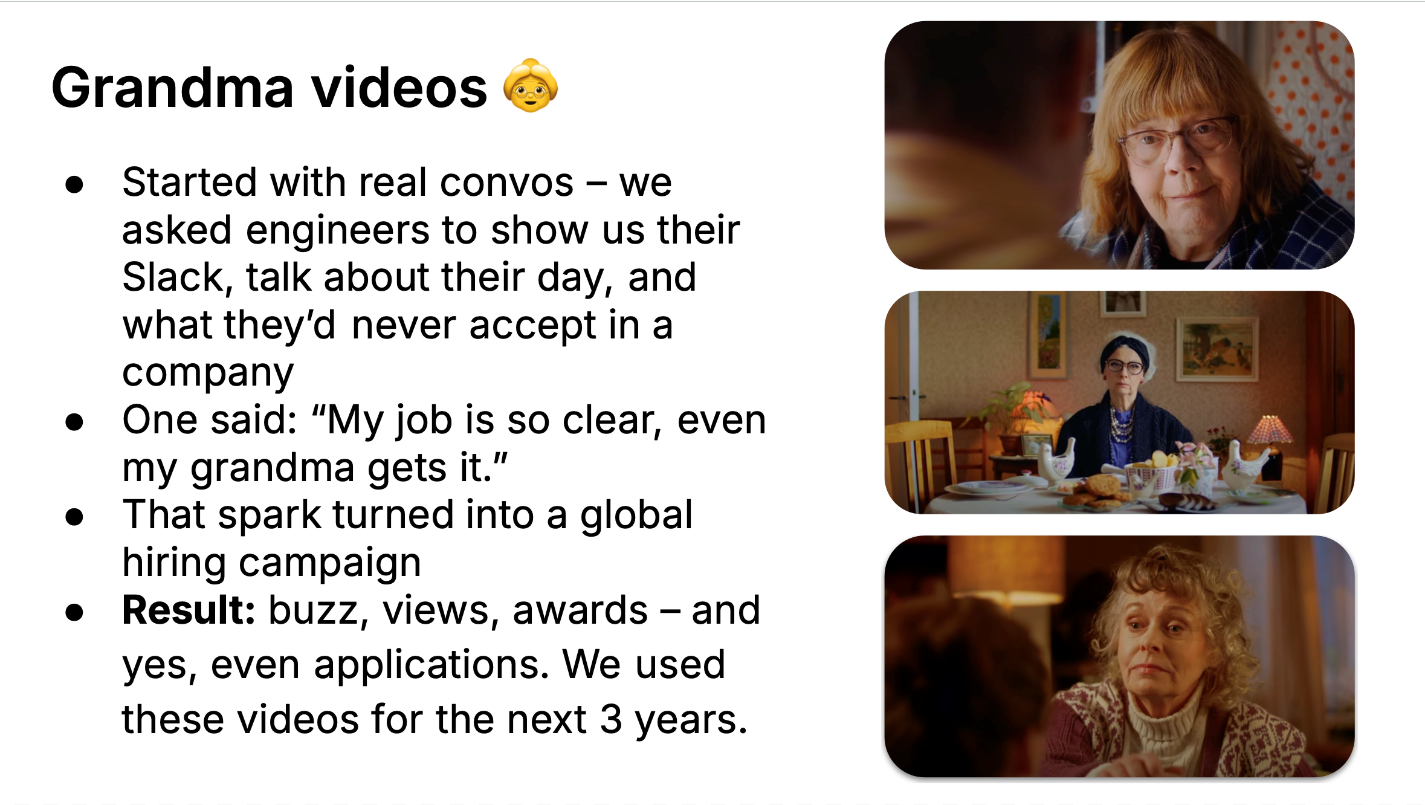
We started by interviewing our engineers. And during one of those chats, someone said, "My job is so clear, even my grandma gets it." That was the moment.
The creative magic came from Liisa Ennuste, our brand team’s creative director. She conducted the interviews, wrote the scripts, and led the whole concept. I was involved from the employer branding side as the client, but I can’t take any creative credit (and definitely neither can my grandpa 😄).
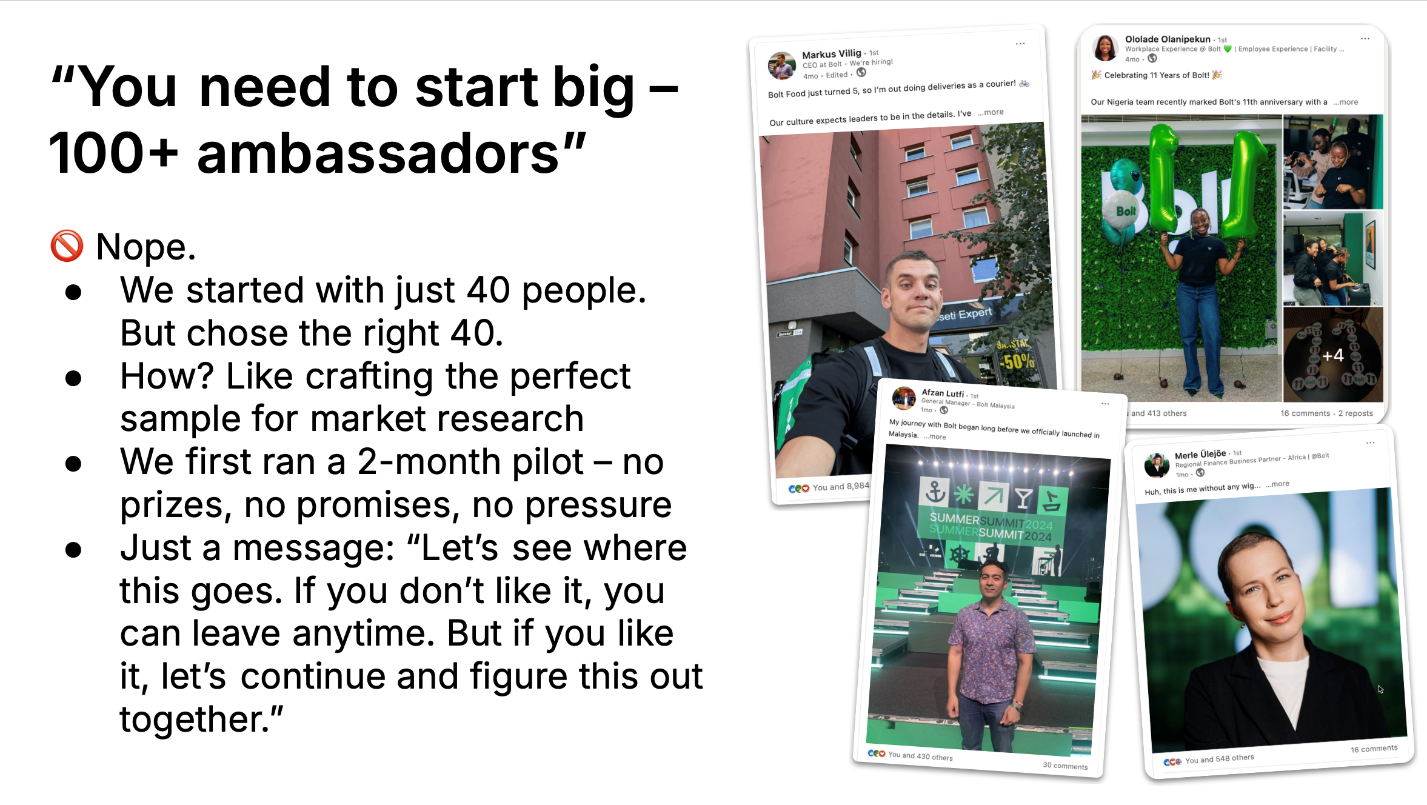
I think it worked because it was different and human. Everyone gets the "grandma" reference. It was sweet, funny and instantly relatable. So often, people try to overcomplicate things when speaking to engineers. But sometimes, the most effective stories aren’t loud or technical, they just have to make you feel something.
Adam: We saw some truly unconventional ideas, from showcasing a day through a dog’s perspective to the screaming seagull concept. Where do you draw inspiration for such out-of-the-box content?
Kadi: Before Bolt, I worked in the entertainment industry — doing social media, videography, PR, and marketing. I often had to make something newsworthy out of nothing.
At Bolt, I’ve been lucky. The culture gives you real freedom — to take ownership, try weird ideas, fail fast, and just see what happens. If it works, great. If not, you try again. That open-mindedness has definitely expanded how I think creatively.
The story with the "day as an engineer’s dog" video was exactly that. Everyone was doing "a day in the life of an engineer," so we thought — what if we flipped it and showed a day in the life of their dog instead? I mean, we’d already used their grandmas… so what was left? 😄 The idea was simple: dogs don’t lie. So they’d tell the story in the most honest way possible.
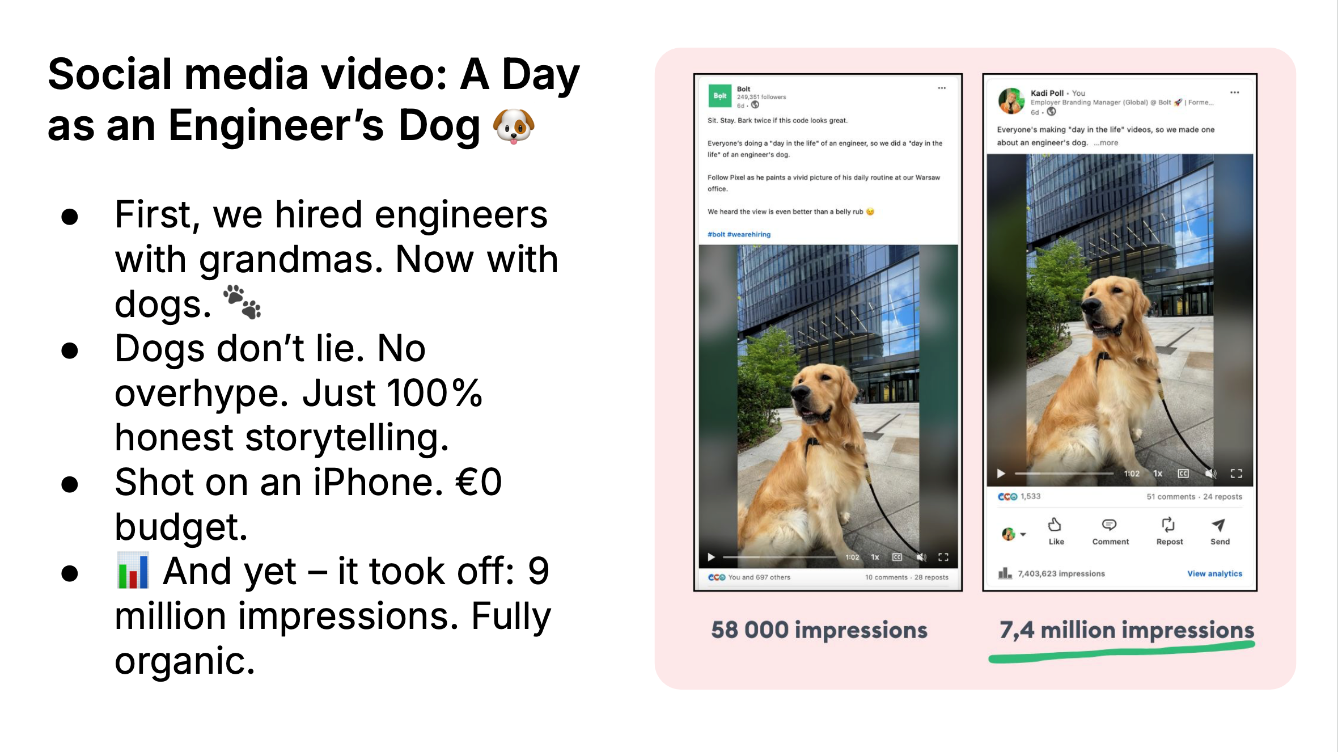
And the screaming seagull story actually came from one of our LinkedIn ambassadors. He suggested that we all post a photo of a screaming seagull on one Friday morning. The idea behind it was simple but powerful — if we can post something that silly and unexpected, then we’ve broken the mental barrier of "what's okay to share" on LinkedIn. We often overthink everything: when to post, what hook is good enough, how much space to leave between sentences, what visual to use… it can get exhausting. But after that post, everything else felt easier. Around 40 ambassadors actually posted it. I nearly fell off my chair 😄 It showed just how willing people were to support each other and let go of overthinking.
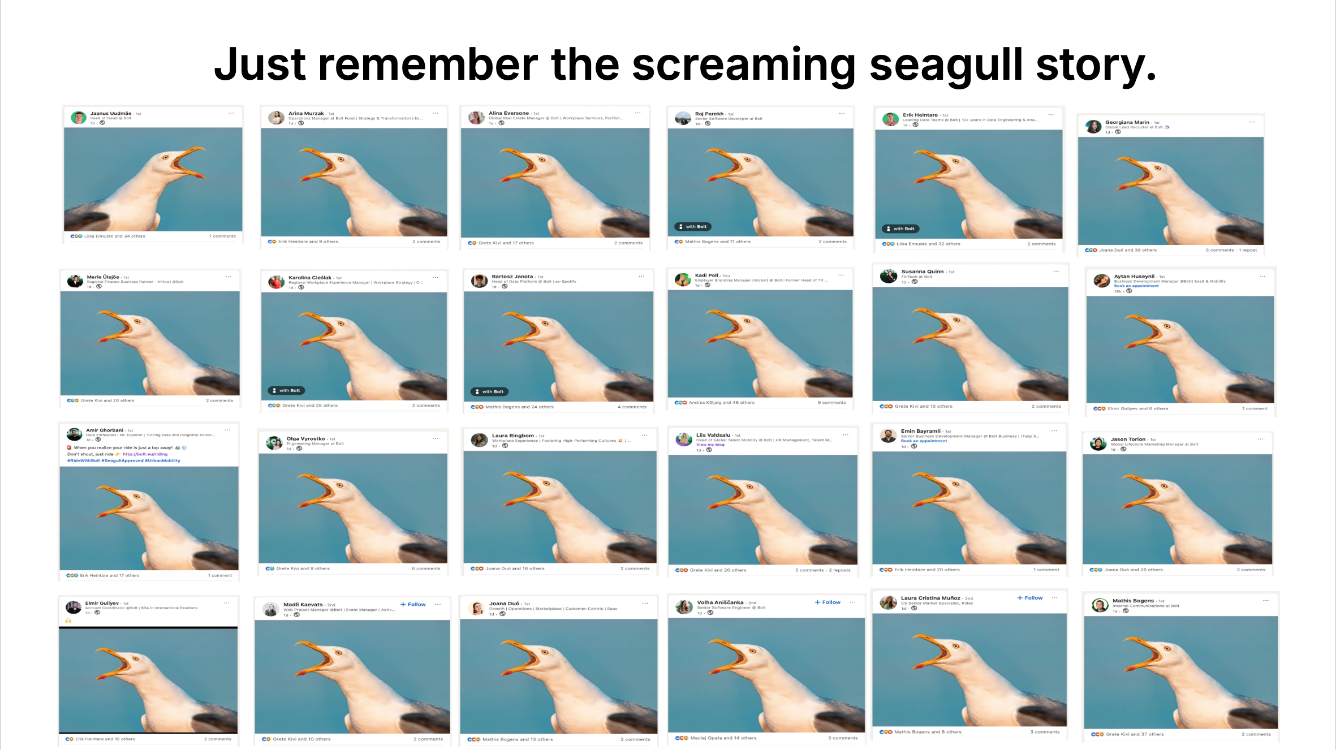
So yeah, it’s a mix: the experience I gained early on, the freedom at Bolt, and the amazing people I get to collaborate with. But if I had to name my favourite creative trick — I just look at what competitors or everyone else are doing… and then do the opposite.
Adam: Bolt is now a global brand, yet many of your solutions avoid unnecessary corporate systems and over-complication. Sometimes an Excel sheet works better to track the ambassador program than implementing an internal comms tool. How do you decide when to keep things simple and when to scale up with more complex solutions?
Kadi: One of our core values at Bolt is "Be frugal" — we consider the impact of every resource we spend. It’s not about cutting corners, it’s about being intentional and solving problems in the simplest, most effective way.
That’s exactly how we approached our employee advocacy program. We didn’t start with a big launch or expensive software. We started scrappy — a private Slack group for community, Google Sheets for tracking, and a Confluence page as our internal hub. Nothing fancy. Just a lightweight system and a small group of motivated people.
We’re big believers in keeping things simple for as long as they work. If a Google Sheet or a Slack group gets the job done, why complicate it? Especially at Bolt, where people already juggle multiple tools.
For me, the real question is always: Does this new system actually solve a problem, or are we just adding layers because it feels more "official"? If the simple setup is still delivering results, there’s no reason to over-engineer it.
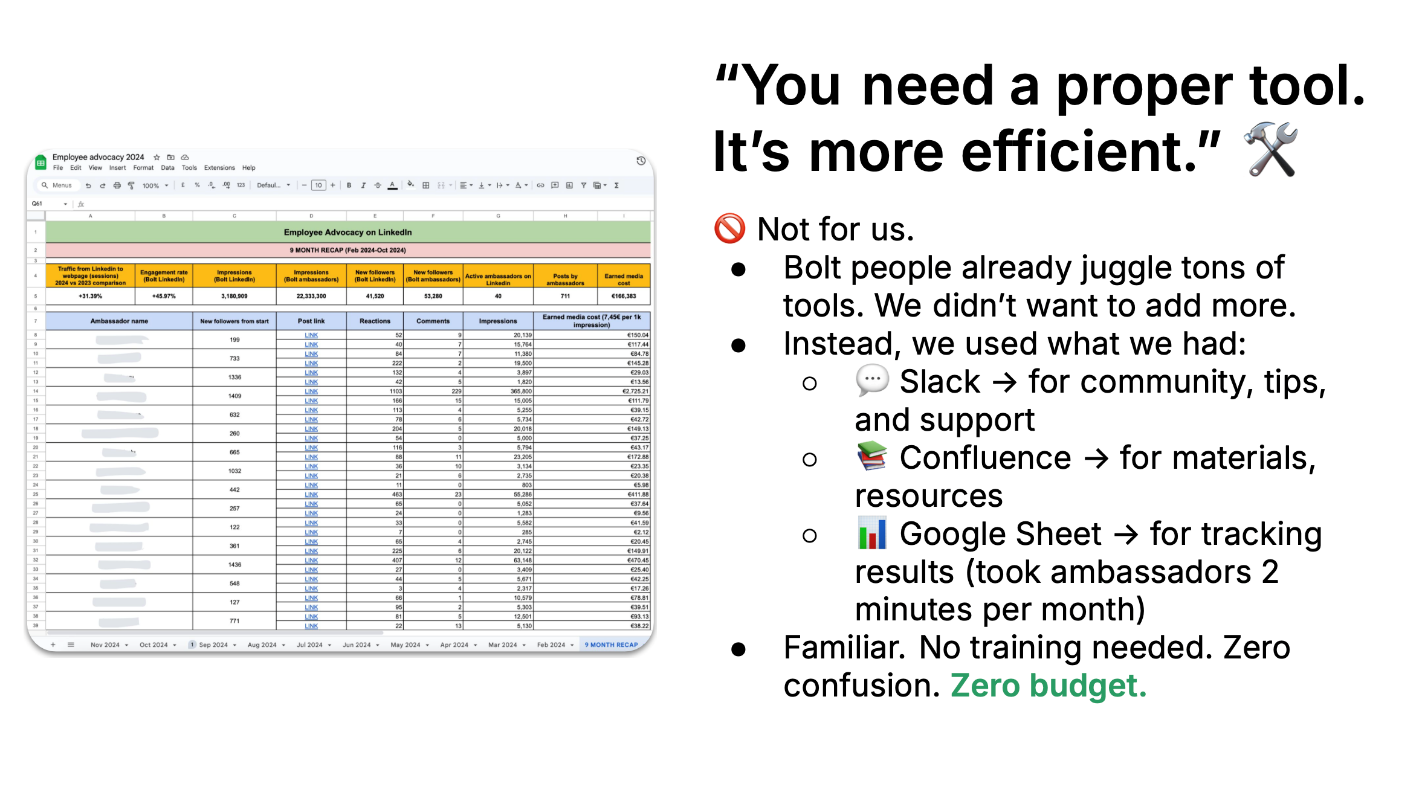
Of course, if things grow — like if we go to 150+ — that’s when we step back and reassess. Will a tool save us time, improve clarity, or help scale without adding unnecessary overhead?
Start scrappy, prove it works, and scale with purpose — not just because it looks good on paper.
Adam: The economic landscape in 2025 is filled with uncertainty, making it challenging for leaders to make clear decisions about employer branding. Yet, companies keep moving forward, and so must their branding efforts. What would you advise to leaders who are struggling to decide how to approach employer branding in such unpredictable times?
Kadi: I’d share three pieces of advice — the same framework we use at Bolt to stay focused.
First, define your end point. You need to be clear on where your responsibility starts and stops. At Bolt, we’ve decided that employer branding ends at the apply button. Everything before that — awareness, interest, consideration — is ours to own. After that, we support, but we don’t lead. That kind of clarity sets boundaries, prevents burnout, and helps you say no to all the "nice-to-have" ideas that don’t serve your real goal.
Second, know your funnel.
Different problems need different strategies. What works for awareness might not work for interest — and what drives interest won’t fix a drop-off at application. So don't copy your competitor’s campaign just because it looks cool. They might be solving a completely different problem. Diagnose your funnel first, and fix your actual challenge — not someone else’s.
Different problems need different strategies. What works for awareness might not work for interest — and what drives interest won’t fix a drop-off at application. So don't copy your competitor’s campaign just because it looks cool. They might be solving a completely different problem. Diagnose your funnel first, and fix your actual challenge — not someone else’s.
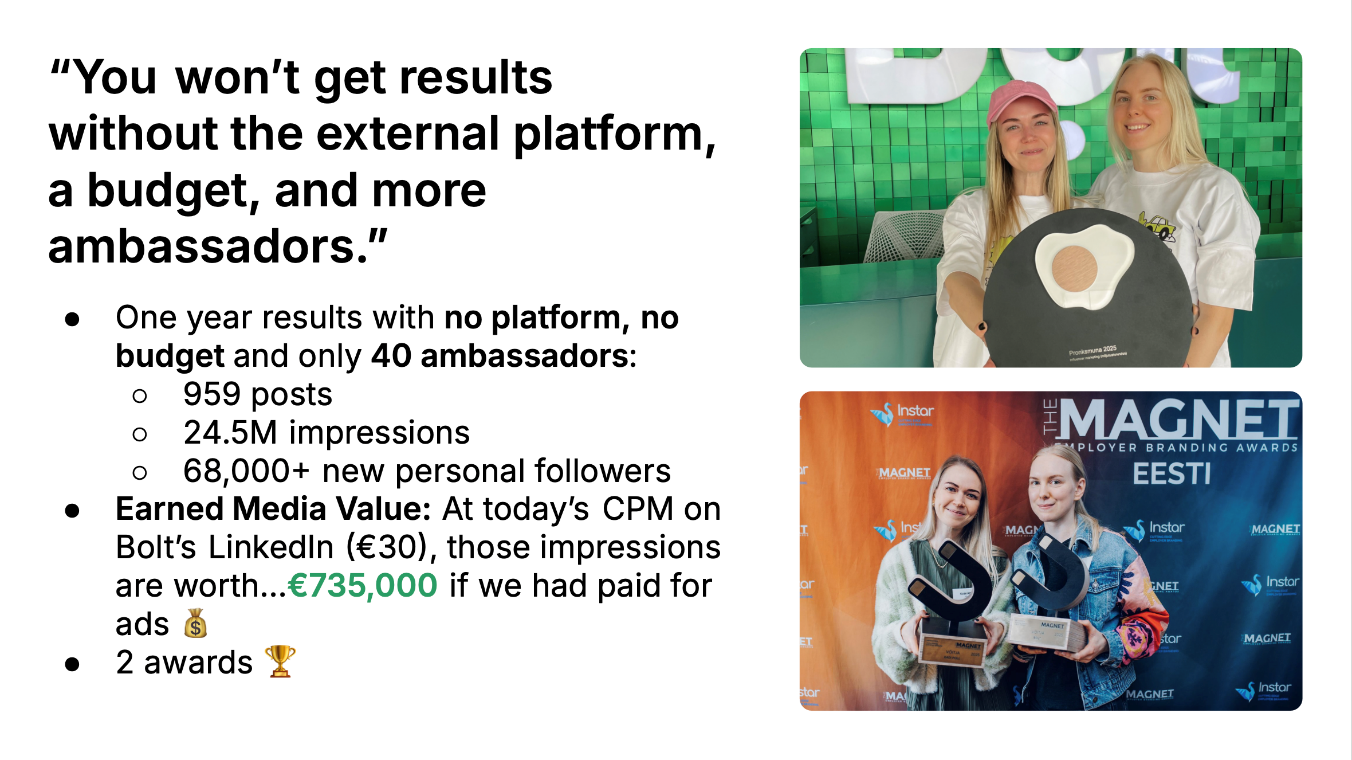
Third, focus on ROI.
Most of us in employer branding have more passion than budget — and that’s okay. You don’t need to say yes to every shiny idea. Test it. Measure it. Tweak it. And if it doesn’t work? Drop it. No guilt. No shame. Just move on and try something else.
Most of us in employer branding have more passion than budget — and that’s okay. You don’t need to say yes to every shiny idea. Test it. Measure it. Tweak it. And if it doesn’t work? Drop it. No guilt. No shame. Just move on and try something else.
So in short: get clear, stay focused, and be brutally honest about what’s working and what’s not.
Adam: Kadi, what this conversation highlights so clearly is that great employer branding is no longer about polished slogans or big production budgets. It’s about the courage to stay human in a system that often pushes for the opposite.
Your ability to distill strategy into emotionally resonant but simple stories is not just refreshing, it’s instructive. In a time when so many leaders are recalibrating their approach to talent, your perspective offers something rare: clarity.
Thank you for this insightful exchange, it’s the kind of dialogue that helps move our industry forward.